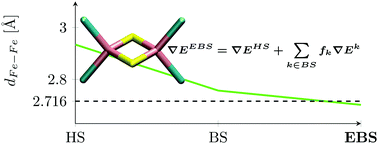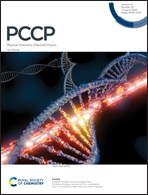Spin-symmetrised structures and vibrational frequencies of iron–sulfur clusters†
Abstract
Calculations of relaxed geometries of multi-centre transition metal compounds are routinely carried out using Broken Symmetry Density Functional Theory. The resulting low-spin open shell electronic state is described by one single Slater determinant and is affected by spin contamination. To alleviate this symmetry breaking, the Extended Broken Symmetry (EBS) approach can be applied to complexes with an arbitrary number of local high-spin metal ions. The actual symmetry is therefore reconstructed through minimization of an effective Hamiltonian leading to a relaxed geometry consistent with the magnetic couplings. In the present work we extend the approach already introduced by [Chu et al., J. Chem. Theory Comput., 2017, 13, 4675] to the calculation of vibrational frequencies. As prototypes we have considered the iron–sulfur clusters Fe2S2Cl42− and Fe4S4Cl4. We have compared the results obtained for different spin states (high spin, broken symmetry and extended broken symmetry) and by using different DFT functionals (B3LYP, OPBE, BP, M06 and B2PLYP) and a post-HF method (SCS-MP2). The data have shown that for specific vibrational modes the EBS technique produces shifts up to 40 cm−1 with respect to the routinely used Broken Symmetry approach, indicating that the use of a consistent spin-symmetrised state is a crucial ingredient for an accurate description of vibrational properties, as certified by the comparison with the experimental data for the Fe2S2Cl42− cluster.

- This article is part of the themed collection: Quantum Theory: The Challenge of Transition Metal Complexes


 Please wait while we load your content...
Please wait while we load your content...